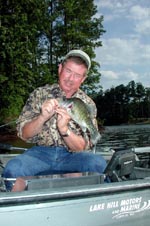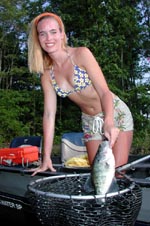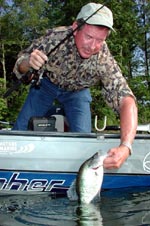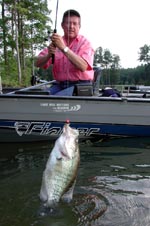
|
Features
|
|
|
|
Books
|
|
|
|
Fun & Games
|
|
|
|
Contact Us
|
|
|
John's Journal... Entry 245, Day 2
10 WAYS TO CATCH THE BIGGEST CRAPPIE OF YOUR LIFE
Fish The Floods (Prespawn)
 "Come
on down to my restaurant, John, about 1 p.m.," Danny Wiles of Birmingham,
Alabama, told me. "I've been fishing, and I've caught a big mess of slab
crappie". I'd always known Wiles as an excellent fisherman, because he
consistently caught large crappie and spotted bass in tailrace areas.
But until I talked with Wiles on this particular day, I hadn't realized
he'd also lost his sanity. Our part of the country had experienced the
worst floods in the history of the state for the two days prior to his
phone call. With rivers about to flow out of their banks all over our
state, I knew the spillways below the dams where Wiles fished had opened
wide and spewed forth fast-running water. No one in his right mind would
have gone fishing the day Wiles went in the wind, rain and muddy-water
conditions. But at lunchtime, when I sat down to drag some tasty, fried,
crappie fillets through a puddle of ketchup, I started picking Wiles'
brain about how to catch bad-weather, monster-sized papermouths.
"Come
on down to my restaurant, John, about 1 p.m.," Danny Wiles of Birmingham,
Alabama, told me. "I've been fishing, and I've caught a big mess of slab
crappie". I'd always known Wiles as an excellent fisherman, because he
consistently caught large crappie and spotted bass in tailrace areas.
But until I talked with Wiles on this particular day, I hadn't realized
he'd also lost his sanity. Our part of the country had experienced the
worst floods in the history of the state for the two days prior to his
phone call. With rivers about to flow out of their banks all over our
state, I knew the spillways below the dams where Wiles fished had opened
wide and spewed forth fast-running water. No one in his right mind would
have gone fishing the day Wiles went in the wind, rain and muddy-water
conditions. But at lunchtime, when I sat down to drag some tasty, fried,
crappie fillets through a puddle of ketchup, I started picking Wiles'
brain about how to catch bad-weather, monster-sized papermouths.
 "I
only seriously crappie fish for about three to four weeks during the early
spring prior to the spawn," Wiles said. "I've found the best crappie fishing
to be on the worst days imaginable for several reasons. When the weather's
bad, lots of water coming over the spillways at the dams, the wind's blowing,
the current in the river is strong, and the water is muddy, rarely will
there be another boat below the dam except mine. So, I don't have any
competition for the fish. Also, I like to fish on those kinds of days
because the current forces the baitfish into eddy holes and pockets downriver
behind rocks, below underwater drop-offs and behind trees that have fallen
into the river. During these flood-water conditions, the baitfish will
school-up in these eddy holes, and the big crappie will stack-up in these
same areas while gorging on shad in preparation for the spawn. Usually
I can catch all the crappie I want to take in one-half day fishing. If
I have a limit of 35 fish, I'll generally have five to 10 crappie that
will weigh 2-pounds each or more." Wiles has discovered one of the best-kept
secrets for successful pre-spawn crappie fishing for big crappie. Fish
when and where other anglers won't, and keep an eye toward the water.
"I
only seriously crappie fish for about three to four weeks during the early
spring prior to the spawn," Wiles said. "I've found the best crappie fishing
to be on the worst days imaginable for several reasons. When the weather's
bad, lots of water coming over the spillways at the dams, the wind's blowing,
the current in the river is strong, and the water is muddy, rarely will
there be another boat below the dam except mine. So, I don't have any
competition for the fish. Also, I like to fish on those kinds of days
because the current forces the baitfish into eddy holes and pockets downriver
behind rocks, below underwater drop-offs and behind trees that have fallen
into the river. During these flood-water conditions, the baitfish will
school-up in these eddy holes, and the big crappie will stack-up in these
same areas while gorging on shad in preparation for the spawn. Usually
I can catch all the crappie I want to take in one-half day fishing. If
I have a limit of 35 fish, I'll generally have five to 10 crappie that
will weigh 2-pounds each or more." Wiles has discovered one of the best-kept
secrets for successful pre-spawn crappie fishing for big crappie. Fish
when and where other anglers won't, and keep an eye toward the water.
 A
few years ago, I'd planned a day off to bank fish for papermouths on a
small stream near my home. As luck would have it, the weather turned foul
two days prior to my trip. At first light, the gray sky threatened a shower.
But I didn't have to work, and I had a bucket of minnows, a rod, a box
of hooks and a few split-shot. Walking down the bank, I stopped at every
point where I say an eddy hole. All day long, I consistently took crappie
in the high water with the fast current. For some reason, those flooding
conditions seemed to trigger a feeding spree among crappie. To catch them,
I found the slack-water areas where the fish could hold out of the current
and feed. But swift current and fast-moving streams aren't the only places
anglers can catch huge high-water crappie. When the spring floods come,
and many rivers and lakes back up into woodlots and fields, crappie will
follow the moving water into the newly inundated lands.
A
few years ago, I'd planned a day off to bank fish for papermouths on a
small stream near my home. As luck would have it, the weather turned foul
two days prior to my trip. At first light, the gray sky threatened a shower.
But I didn't have to work, and I had a bucket of minnows, a rod, a box
of hooks and a few split-shot. Walking down the bank, I stopped at every
point where I say an eddy hole. All day long, I consistently took crappie
in the high water with the fast current. For some reason, those flooding
conditions seemed to trigger a feeding spree among crappie. To catch them,
I found the slack-water areas where the fish could hold out of the current
and feed. But swift current and fast-moving streams aren't the only places
anglers can catch huge high-water crappie. When the spring floods come,
and many rivers and lakes back up into woodlots and fields, crappie will
follow the moving water into the newly inundated lands.
 I
often fish along a flood plain on the Tennessee/Tombigbee Waterway on
the Mississippi border. Using a flat-bottomed johnboat, I go to the river
when the water's up and have made some large catches in freshly-flooded
woodlots during the early part of the spring. I particularly like to fish
in these conditions around newly-inundated briar thickets where baitfish
concentrate. The crappie will school-up and feed on these baitfish. To
take these shallow-water crappie, fish with minnows and jigs, and hold
the baits only 1 or 2 inches under the surface. In muddy and rising water,
light doesn't penetrate very deeply. Most of the baitfish usually will
swim in less than a foot of water. The baitfish will follow the moving
water into the shallows to feed off the new plant life and microscopic
organisms that come into the lake as the water floods. By keeping your
bait in that very-shallow water, your minnows or jigs will appear more
natural to the crappie, and you'll take more fish. I find that boats are
just too large to fish these shallow-water regions effectively. I prefer
to use a small johnboat, a one- or a two-man type of boat, or a canoe,
which I can easily maneuver and fish from in backwater areas. In many
of these inaccessible regions, I'll have no competition for these flood-plain
papermouths. Crappie belong to the sunfish family, the same as black bass,
and will react to rising floodwaters just as bass do. They'll position
themselves near the edge of the shore in very shallow water, facing toward
the bank where the baitfish will run. The crappie fisherman who understands
how and where to find bass when rivers flood also will know where to look
for crappie under the same circumstances.
I
often fish along a flood plain on the Tennessee/Tombigbee Waterway on
the Mississippi border. Using a flat-bottomed johnboat, I go to the river
when the water's up and have made some large catches in freshly-flooded
woodlots during the early part of the spring. I particularly like to fish
in these conditions around newly-inundated briar thickets where baitfish
concentrate. The crappie will school-up and feed on these baitfish. To
take these shallow-water crappie, fish with minnows and jigs, and hold
the baits only 1 or 2 inches under the surface. In muddy and rising water,
light doesn't penetrate very deeply. Most of the baitfish usually will
swim in less than a foot of water. The baitfish will follow the moving
water into the shallows to feed off the new plant life and microscopic
organisms that come into the lake as the water floods. By keeping your
bait in that very-shallow water, your minnows or jigs will appear more
natural to the crappie, and you'll take more fish. I find that boats are
just too large to fish these shallow-water regions effectively. I prefer
to use a small johnboat, a one- or a two-man type of boat, or a canoe,
which I can easily maneuver and fish from in backwater areas. In many
of these inaccessible regions, I'll have no competition for these flood-plain
papermouths. Crappie belong to the sunfish family, the same as black bass,
and will react to rising floodwaters just as bass do. They'll position
themselves near the edge of the shore in very shallow water, facing toward
the bank where the baitfish will run. The crappie fisherman who understands
how and where to find bass when rivers flood also will know where to look
for crappie under the same circumstances.
Tomorrow: The Spawn
Check back each day this week for more about 10 WAYS TO CATCH THE BIGGEST CRAPPIE OF YOUR LIFE ...
Day 1 - Two Tips for Big
Crappie
Day 2 - Fish The Floods (Prespawn)
Day 3 - The Spawn
Day 4 - Fish Deep With Tiny Jigs (Postspawn)
Day 5 - Fish Hidden Spots: How To Catch Big
Crappie Anytime